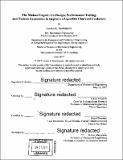The Makaa Project : co-design, performance testing, and techno-economics to improve a Ugandan charcoal cookstove
Author(s)
Bustamante, Lauren E
DownloadFull printable version (14.21Mb)
Alternative title
Co-design, performance testing, and techno-economics to improve a Ugandan charcoal
Other Contributors
Massachusetts Institute of Technology. Department of Mechanical Engineering.
Advisor
J. Kim Vandiver and Daniel Sweeney.
Terms of use
Metadata
Show full item recordAbstract
Like many developing nations in Africa, Uganda has a very high reliance on solid fuels such as firewood and charcoal. These solid fuels are used in conjunction with a variety of cooking methods, ranging from three stone fires to improved cookstoves. Appropriate Energy Saving Technologies (AEST) is a social business enterprise that manufactures and distributes the Makaa charcoal cookstove and a long-time partner of MIT's D-Lab. This work is a collaboration with AEST to improve the performance, usability, and manufacturability of the Makaa stove. A one-day co-design workshop was held at the AEST site in Soroti to engage users, fabricators, and AEST employees in brainstorming and investigating opportunities to improve the design of the Makaa stove. While the designs researched at the workshop primarily addressed concerns with usability and manufacturability, two additional designs were selected to be prototyped and tested using the water boil test (WBT) procedure developed by the Global Alliance for Clean Cookstoves (GACC), which measures the efficiency and emissions of a cookstove. The two prototyped designs used aluminum foil and vermiculite for insulation and were compared to the two Makaa stoves currently in production, the clay and metal grate models. The results from the WBTs were used to calculate the stoves' tier ratings according to the IWA Tiers of Performance, set by the GACC. Detailed techno-economic analyses were also performed in order to calculate the total cost of production for each of the four stove models. Combining the results from the performance testing with the cost analyses revealed that the most cost-effective design is a combination of the metal grate and vermiculite models. This design maximized performance and usability while also minimizing the time and cost of production. Recommendations were made for further prototyping and testing, and a cost-analysis spreadsheet was made available for future techno-economic analysis.
Description
Thesis: S.M., Massachusetts Institute of Technology, Department of Mechanical Engineering, 2017. Cataloged from PDF version of thesis. Includes bibliographical references (pages 45-46).
Date issued
2017Department
Massachusetts Institute of Technology. Department of Mechanical EngineeringPublisher
Massachusetts Institute of Technology
Keywords
Mechanical Engineering.